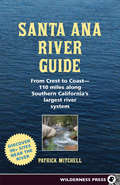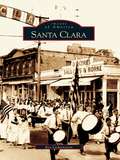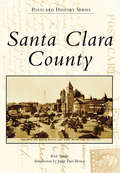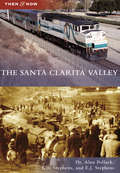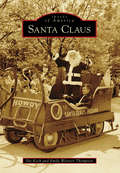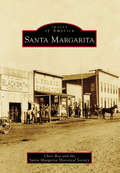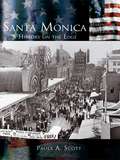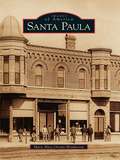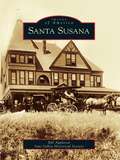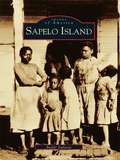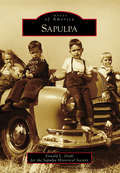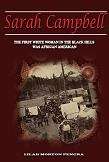- Table View
- List View
Santa Ana Mountains History, Habitat and Hikes: On the Slopes of Old Saddleback and Beyond
by Patrick MitchellThe majestic Santa Ana Mountains cover one thousand square miles and much of the Cleveland National Forest in Orange, Riverside and San Diego Counties. Unlike other designated wild lands close to huge population centers, the rugged Santa Anas remain largely primordial. Dominated by Old Saddleback and its twin peaks of Modjeska and Santiago, this beautiful range, visible from much of the Los Angeles Basin, remains the last intact coastal ecosystem in Southern California. Home to Native Americans, Spanish missionaries, vaqueros, sheep barons, bandits and suburban developers, the Santa Anas were traversed by mountain man Jedediah Smith, explorer John C. Fremont, lawman Wyatt Earp and other historic figures. Join author Patrick Mitchell for this first comprehensive volume on the natural and cultural histories of the great Santa Anas.
Santa Ana River Guide
by Patrick MitchellThe Santa Ana River Guide by Patrick Mitchell reveals both the wild and urban sides of the Southland’s most important river. The book relates the river’s natural and human history, geology, and current conditions and provides all the information necessary to plan an outing on or near the river. It is also a call to action for further protecting and restoring the river. Organized into six geographical sections corresponding to the river’s "reaches,” the book’s individual entries include an extensive description of each park and preserve, location and access information, and highlights of what to do there.
Santa Barbara Chef's Table: Extraordinary Recipes from the American Riviera (Chef's Table)
by James FraioliCelebrating Santa Barbara's best restaurants and eateries with recipes and photograph, Santa Barbara Chef's Table profiles signature “at home” recipes from 40 legendary dining establishments. A keepsake cookbook for tourists and locals alike, the book is a celebration of Santa Barbara's farm-to-table way of life.
Santa Clara
by Bea LichtensteinSanta Clara, named for the prosperous Spanish mission founded there in 1777, lies in a place once called the "Valley of Heart's Delight." Its black fertile loam produced thousands of acres of bright flowers and vegetables for the largest seed farm in the world, and much of the rest was blanketed in springtime with fruit blossoms. The wealth of its pre-eminent tanning, wood manufacturing, and fruit packing industries gave way to another type of opportunity in the 1950s with the emergence of the semi-conductor. The tiny chip that transformed the world of communication spawned new companies here like Intel, National Semi-Conductor, and Applied Materials, which earned the now urban economic powerhouse a new name, Silicon Valley.
Santa Clara County (Postcard History Series)
by Rick Sprain Judge Paul BernalOriginally inhabited by the Ohlone, Santa Clara County was one of 27 counties created when California achieved statehood in September 1850. The first settlements began when Fr. Junípero Serra established the Mission Santa Clara de Asís in 1777. For over 100 years, the valley was known for its rich soil and thriving farm region. In the 1940s and 1950s, William Hewlett and David Packard, along with Lockheed, IBM, and hundreds of other companies, altered the scope of Santa Clara County forever. With the influx of tech jobs and ensuing building boom, the county went from "Valley of the Heart's Delight" to "Silicon Valley."
Santa Clarita Valley
by Santa Clarita Valley Historical Society John BostonA trade crossroads dating back to Native American times, Santa Clarita may be relatively new in the story of Los Angeles County's suburban sprawl, but old-timers also recall it as the "Navel of the Universe." A Chinese general once declared the Santa Clarita Valley one of the top 10 military targets on Earth. Located east of the Ventura County line where the valley creates a break in the Angeles National Forest, Santa Clarita has been home to cowboys, movie stars, farmers, and pistol fighters. With a diverse population of 250,000 today, the Santa Clarita Valley still boasts an eclectic heritage. The West's first major oil refinery is located here. The ground was bloodied by at least 21 deaths in one of America's last and greatest range wars. And local lore has maintained that the world's largest grizzly bear, weighing more than a ton, was shot here.
Santa Clarita Valley, The
by E. J. Stephens Dr Alan Pollack Kim StephensBorn in 1987 as the nation's first new city with a population greater than 100,000, Santa Clarita, California, has a fascinating history that stretches back to the rugged Wild West era. Hollywood recreates this history in Santa Clarita and its surrounding valley, to the delight of movie fans worldwide.
Santa Claus (Images of America)
by Pat Koch Emily ThompsonSanta Claus, Indiana, acquired its famous name in 1856 and has been celebrating the spirit of Christmas ever since. Postmaster James Martin began answering children's letters to Santa and his elves in 1914, a tradition that continues to this day and makes Santa Claus a favored destination for those seeking the holiday spirit. The town's unique name prompted Robert Ripley to feature it in his popular cartoon strip, and businessmen such as Carl Barrett and Milton Harris raced to erect Christmas attractions as early as 1935. Beating Walt Disney by nearly a decade, Louis J. Koch opened Santa Claus Land, the nation's first theme park, in 1946. Today, visitors still flock to Santa Claus to share in the magic of "America's Christmas Hometown."
Santa Cruz Wharf (Images of America)
by Geoffrey DunnFor a century now, the Santa Cruz Wharf has shone as one of the crown jewels of the Pacific Coast, and today it serves as a gateway to the Monterey Bay National Marine Sanctuary. What began as a shipping pier quickly morphed into the home of the colorful and fabled Santa Cruz Italian fishing colony. In its most recent iteration, the wharf serves as the primary destination for upward of four million annual visitors to Santa Cruz County. Since the time of the California Gold Rush in the late 1840s, there have been six wharves, or wooden piers, along the Santa Cruz waterfront, providing critical links for the local community to regional and global markets. The Santa Cruz Wharf, and all the 4,528 wooden piles that compose it, provides both external and internal vistas not found anywhere on land and is a place for contemplation, reflection, and quietude.
Santa Fe Flavors: Best Restaurants And Recipes
by Anne HillermanThe New York Times bestselling author and restaurant critic takes readers on a foodie tour of Santa Fe—complete with recipes from more than 50 restaurants. A city known for fine dining, Santa Fe boasts many wonderful restaurants, from famous gourmet establishments to delicious mom-and-pop diners. In Santa Fe Flavors, restaurant critic Anne Hillerman takes connoisseurs on a whirlwind tour through some of the city&’s most delectable eateries. Along with recommendations on where to find truly memorable meals, Hillerman also provides diners the chance to re-create some of their favorite dishes with recipes contributed by restaurant chefs. Hillerman takes readers inside more than fifty restaurants, introducing both celebrated and undiscovered chefs. Featured restaurants include Bobcat Bites, El Farol, The Pink Adobe, Blue Heron at Sunrise Springs, Coyote Cafe, Geronimo, Trattoria Nostrani, and more.
Santa Fe's Historic Hotels
by Paul R. SecordIt is unknown when the earliest commercial lodging establishment came to Santa Fe. However, the first clear identification of a hotel at a specific site in Santa Fe dates to 1833, when Mary and James Donoho operated an inn on the site of what is now La Fonda on the Plaza, the Inn at the End of the Trail. This book presents an overview of Santa Fe hotels from the past and highlights the city's important remaining historic hotels. The chapters include key establishments that had their start in the early 20th century and continue in operation today. Most of them are still in buildings with considerable historic and architectural significance, such as Bishop's Lodge, La Fonda, and the St. Francis. A chapter on an iconic Route 66 motor court, which is now known as the lovingly preserved El Rey Inn, is also included.
Santa Fe’s Fonda: The Story of the Old Inn at the End of the Trail (Landmarks)
by Allen R. SteeleFor the first two centuries of Santa Fe's history, weary wayfarers were out of luck. Not only did the Spanish authorities enforce a strict travel ban on foreign visitors, but there was also no place to stay in the territorial capital. That all changed in the 1820s. When Mexico gained independence, a flood of traffic cascaded down the Santa Fe Trail, and the Plaza became a hub of hospitality and trade. From the Exchange Hotel to La Fonda, the inn on the corner of San Francisco Street represented one of the most welcome landmarks in the West. Author Allen Steele recounts stories of trailblazing pioneers and the lodging on which their daring depended.
Santa Margarita (Images of America)
by Santa Margarita Historical Society Cheri RoeSanta Margarita de Cortona was founded in 1775 as part of the original Spanish mission system. Its asistencia, in fact, has been considered a lost mission. Santa Margarita Ranch was later founded from a Mexican land grant. In 1889, the arrival of the Southern Pacific Railroad, with its terminus in Santa Margarita, created a boomtown with dance halls, blacksmiths, hotels, pool halls, saloons, and a jail. And with the popularity of auto travel half a century later, Santa Margarita was once again revitalized with garages, gas stations, motor inns, restaurants, and bars. It fell into a deep sleep, however, as Highway 101 bypassed the town in the mid-1950s. Landlocked by the 17,000-plus-acre Santa Margarita Ranch, the town has remained frozen in time until recently.
Santa Monica: A History on the Edge
by Paula A. ScottAn icon of Southern California and one of America's most imaginative and vibrant cities--the fitting destination at the end of Route 66--Santa Monica lies on the brink of the West and is known throughout the nation for its beaches and its Hollywood A-list locals With a foundation built by the Gabrielino Indians and molded by Spanish and Mexican land grants, railroad battles, and a constant influx of settlers, Santa Monica became an oceanside haven for actors and airplane companies, road races and ranchers.
Santa Paula
by Mary Alice HendersonSanta Paula was built on the foundations of citrus cultivationand oil production. Ventura County's first irrigated 100-acreorange and lemon orchard was planted at Santa Paula in 1874, and the original 1888 harvest was so plentiful and delicious that the Limoneira Ranch Company was incorporated in 1893 and continues to thrive. Oil seeps brought wildcatters, and California's first gusher came in at Santa Paula in 1888. The town's twin notorieties through the 20th century were its designation as the "citrus capital of the world" and as the birthplace of the Union Oil Company of California (UNOCAL). Lemons and avocados remain the primary tree crops, the oil fields still produce, and the small-town character of bygone days has been preserved--Santa Paula has the largest concentration of vintage structures in the county.
Santa Paula: 1930-1960
by Mary Alice HendersonThis visual history of the 20th century's middle decades in Santa Paula illustrates how a rural city settled into its middle age. As a sequel to Images of America: Santa Paula, which covered the pioneering and settlement years of 1870 to 1930, it continues this Ventura County city's story through the Depression decade and the World War II and Korean War home front years that led up to the sixties. The time from 1930 to 1960 was prosperous for the two main industries in Santa Paula and its environs: citrus cultivation and oil production. The population increases reflected the job opportunities that these industries presented, bringing other families, businesses, and opportunities to the growing city.
Santa Rosa County
by Laurie GreenThe history of Santa Rosa County is closely associated with wood and water. Harvesting of the huge virgin pine trees that covered the area attracted industry and labor. Streams and rivers powered the machinery used to harvest the timber and also provided the means of transport. The sawmills, shipyards, turpentine stills, and related industriesmade Santa Rosa County the most industrialized county in Florida prior to the Civil War. After the war, the county rebuilt from the damage done not by raiding Yankee troops, but by retreating Confederates. The whine of the steam saw signaled the beginning of an era of great prosperity, an era that saw Milton build some of its most famous buildings and prominent businesses.
Santa Susana
by Bill Appleton Simi Valley Historical SocietySanta Susana is one of three rural towns in Simi Valley that began at the turn of the 20th century. The town derives its name from the surrounding mountains, Sierra de Santa Susanna, and grew up alongside the railroad depot built by the Southern Pacific Company in 1903. The history of Santa Susana can be traced back to the Chumash Indian village of Ta'apu and a Spanish land grant, El Rancho Simi. The area was first surveyed by the Simi Valley Land and Water Company in 1887 for the sale of ranches. By the mid-1950s, Santa Susana had become a recognized agricultural center, noted for citrus and walnut production. Corriganville and Bottle Village are unique tourist destinations that originated near the Santa Susana Airport. In the surrounding mountains, quirky religious groups established communes away from the public with strange names and stories: Pisgah Grande, The Great Eleven Club, and WKFL Fountain of the World.
Santa's Village: Tales Of Summer Fun, Hijinx And Debauchery As Told By The People Who Worked There (Images of America)
by Phillip L. WenzSince 1959, Santa's Village in Dundee has entertained millions. The park was born of a man who as a child had no real Christmas. Glenn Holland grew up in California during the Great Depression. His parents died by the time he was 18 years old, leaving him to care for his younger sister. As a father, he tried to give his own children the type of Christmas that he only knew in his dreams. In the early 1950s, struck with inspiration, Holland sat at his kitchen table one day and started to sketch his idea for a Christmas fairyland where all the magic of the holiday would come to life: Santa's Village. Holland and general contractor Putnam Henck builtthree Santa's Villages, two in California and one in Dundee.
Sapelo Island: People And Place On A Georgia Sea Island (Images of America)
by Buddy SullivanThe barrier islands of the south Atlantic coastline have for years held a deep attraction for all who have come into contact with them. Few, however, can compare with the mystique of Sapelo Island, Georgia. This unique semitropical paradise evokes a time long forgotten, when antebellum cotton plantations dominated her landscape, all worked by hundreds of black slaves, the descendants of whom have lived in quiet solitude on the island for generations. For more than 50 years of the twentieth century, two millionaires held sway on Sapelo, and it is their story, interwoven with that of the island's residents, that unfolds within the pages of this book. Almost 200 photographs provide testimony to the dynamic forces and energies implanted upon Sapelo by two men, Howard E. Coffin, a Detroit automotive pioneer, and Richard J. Reynolds Jr., heir to a huge North Carolina tobacco fortune. Beginning with a photographic essay about Sapelo's antebellum plantation owner, Thomas Spalding, Sapelo Island moves into the primary focus of the story, the years from 1912 to 1964, an era of grandeur that has left a rich photographic legacy.
Sapulpa (Images of America)
by Donald L. Diehl for the Sapulpa Historical SocietySapulpa is named after a young Creek Indian who came to the area around 1840 and opened a trading post near Pole Cat Creek. Sapulpa’s arrival in Indian Territory was independent of the famed “Trail of Tears,” a term used for the federal government’s forced removal of Creek (Muskogee) and other tribes from their southern homelands in the 1830s. The area that would become the Creek Nation is a small part of the land acquired by the United States after the Louisiana Purchase in 1803. At one time, Spain, England, and France each laid claim to Oklahoma. Trails, rails, and oil; bricks, clay, and glass; and streetcars, highways, and automobiles are all parts of the historic community of Sapulpa. The diverse people who came to the area—Indians, cowboys, railroaders, settlers, loggers, farmers, wildcatters, oilmen, businessmen, manufacturers, workers, and dreamers—recorded the town’s story, as captured in photographs, beginning more than a century ago. Sapulpa was and remains a crossroads in more ways than one.
Saraband: The Memoirs of E.L. Mascall
by E. L. MascallIn this book, 87-year-old Anglo-Catholic theologian Eric Mascall writes entertainingly about his ancestry and infancy, school and university days, early teaching career and his decision to seek ordination, life in the universities at Lincoln and Oxford for 40 years, and his recent travels and pursuits.
Sarah Campbell: The First White Woman in the Black Hills Was African American
by Lilah PengraSarah Campbell is most well-known for accompanying Custer on his 1874 Expedition to the Black Hills as the cook for the army sutler. This impeccably researched and wonderfully told biography traces Campbell's roots to her 1823 birth to Marianne, enslaved by the fur-trading Duchouquettes. Campbell sued for and won her freedom at the age of 14 after a three-year court battle in St. Louis. The book delves into her values and how she protected herself from the racism of the day by her use of self-deprecating humor. Because Campbell claimed to be the "first white woman" in the Black Hills, the author explores the vernacular race and class connotations of the label "white" and being addressed as "Aunt Sally." Campbell returned to the Black Hills of Dakota Territory in 1876, located five silver mines and died on her ranch near Galena, DT, in 1888.
Saranac Lake
by Neil SurprenantThe first settlers came to Saranac Lake beginning in 1819 to make a living from the forests of the Adirondacks. In the 1870s, wealthy city dwellers discovered the hunting, fishing, boating, and hiking available in these beautiful mountains, and Saranac Lake became the hub for local tourism. By 1900, Dr. Edward Livingston Trudeau had established the fresh-air cure for tuberculosis, and Saranac Lake became America's "Pioneer Health Resort." A culture of excellent medical facilities, an active arts scene, and a great library and educational system combined with traditional Adirondack values to make Saranac Lake "the Little City of the Adirondacks," a special place to everyone who got to know it. Later in the 20th century, the focus shifted from health to scientific research, education, state government offices, and the more middle class tourist industry of the post-World War II era. This designated All-America City has retained that special character.


